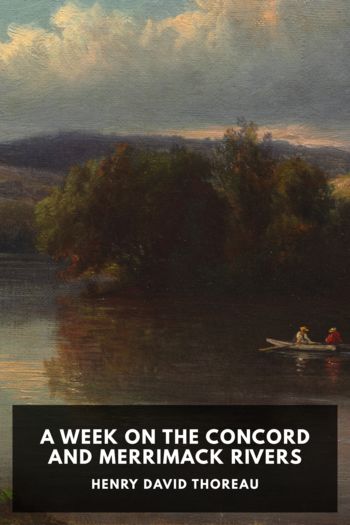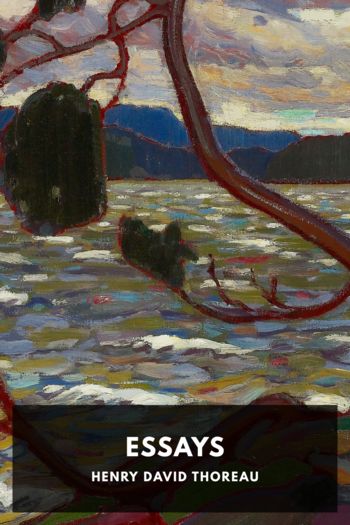A Week on the Concord and Merrimack Rivers by Henry David Thoreau (literature books to read TXT) 📕

Description
In 1839, Thoreau and his brother took a small boat upriver and back. Some years later, while in his cabin at Walden Pond, he gathered his notes from that journey and other writings from his journals, and composed this, his first book.
Like the rivers it describes, the book meanders through varying territories and climates. He writes of the natural surroundings they encounter and of the history of the region, but also takes long and remarkable detours through topics like friendship, history, a comparison of Christianity and Hinduism, Vedic literature, government and conscience, Thoreau’s philosophy of literature, monuments and graveyards, poetry (in particular Ossian, Chaucer, and certain minor Greek poets), and the satires of Aulus Persius Flaccus. Thoreau also includes several poems of his own.
Thoreau had the first edition of this book published at his own expense, and at first it struggled to find an audience. “I have now a library of nearly 900 volumes,” he remarked at one point, “over 700 of which I wrote myself.”
Read free book «A Week on the Concord and Merrimack Rivers by Henry David Thoreau (literature books to read TXT) 📕» - read online or download for free at americanlibrarybooks.com
- Author: Henry David Thoreau
Read book online «A Week on the Concord and Merrimack Rivers by Henry David Thoreau (literature books to read TXT) 📕». Author - Henry David Thoreau
The Chivin, Dace, Roach, Cousin Trout, or whatever else it is called, Leuciscus pulchellus, white and red, always an unexpected prize, which, however, any angler is glad to hook for its rarity. A name that reminds us of many an unsuccessful ramble by swift streams, when the wind rose to disappoint the fisher. It is commonly a silvery soft-scaled fish, of graceful, scholarlike, and classical look, like many a picture in an English book. It loves a swift current and a sandy bottom, and bites inadvertently, yet not without appetite for the bait. The minnows are used as bait for pickerel in the winter. The red chivin, according to some, is still the same fish, only older, or with its tints deepened as they think by the darker water it inhabits, as the red clouds swim in the twilight atmosphere. He who has not hooked the red chivin is not yet a complete angler. Other fishes, methinks, are slightly amphibious, but this is a denizen of the water wholly. The cork goes dancing down the swift-rushing stream, amid the weeds and sands, when suddenly, by a coincidence never to be remembered, emerges this fabulous inhabitant of another element, a thing heard of but not seen, as if it were the instant creation of an eddy, a true product of the running stream. And this bright cupreous dolphin was spawned and has passed its life beneath the level of your feet in your native fields. Fishes too, as well as birds and clouds, derive their armor from the mine. I have heard of mackerel visiting the copper banks at a particular season; this fish, perchance, has its habitat in the Coppermine River. I have caught white chivin of great size in the Aboljacknagesic, where it empties into the Penobscot, at the base of Mount Ktaadn, but no red ones there. The latter variety seems not to have been sufficiently observed.
The Dace, Leuciscus argenteus, is a slight silvery minnow, found generally in the middle of the stream, where the current is most rapid, and frequently confounded with the last named.
The Shiner, Leuciscus crysoleucas, is a soft-scaled and tender fish, the victim of its stronger neighbors, found in all places, deep and shallow, clear and turbid; generally the first nibbler at the bait, but, with its small mouth and nibbling propensities, not easily caught. It is a gold or silver bit that passes current in the river, its limber tail dimpling the surface in sport or flight. I have seen the fry, when frightened by something thrown into the water, leap out by dozens, together with the dace, and wreck themselves upon a floating plank. It is the little light-infant of the river, with body armor of gold or silver spangles, slipping, gliding its life through with a quirk of the tail, half in the water, half in the air, upward and ever upward with flitting fin to more crystalline tides, yet still abreast of us dwellers on the bank. It is almost dissolved by the summer heats. A slighter and lighter colored shiner is found in one of our ponds.
The Pickerel, Esox reticulatus, the swiftest, wariest, and most ravenous of fishes, which Josselyn calls the Freshwater or River Wolf, is very common in the shallow and weedy lagoons along the sides of the stream. It is a solemn, stately, ruminant fish, lurking under the shadow of a pad at noon, with still, circumspect, voracious eye, motionless as a jewel set in water, or moving slowly along to take up its position, darting from time to time at such unlucky fish or frog or insect as comes within its range, and swallowing it at a gulp. I have caught one which had swallowed a brother pickerel half as large as itself, with the tail still visible in its mouth, while the head was already digested in its stomach. Sometimes a striped snake, bound to greener meadows across the stream, ends its undulatory progress in the same receptacle. They are so greedy and impetuous that they are frequently caught by being entangled in the line the moment it is cast. Fishermen also distinguish the brook pickerel, a shorter and thicker fish than the former.
The Horned Pout, Pimelodus nebulosus, sometimes called Minister, from the peculiar squeaking noise it makes when drawn out of the water, is a dull and blundering fellow, and like the eel vespertinal in his habits, and fond of the mud. It bites deliberately as if about its business. They are taken at night with a mass of worms strung on a thread, which catches in their teeth, sometimes three or four, with an eel, at one pull. They are extremely tenacious of life, opening and shutting their mouths for half an hour after their heads have been cut off. A bloodthirsty and bullying race of rangers, inhabiting the fertile river bottoms, with ever a lance in rest, and ready to do battle with their nearest neighbor. I have observed them in summer, when every other one had a long and bloody scar upon his back, where the skin was gone, the mark, perhaps, of some fierce encounter. Sometimes the fry, not an inch long, are seen darkening the shore with their myriads.
The Suckers, Catostomi bostonienses and tuberculati, Common and Horned, perhaps on an average the largest of our fishes, may be seen in shoals of a hundred or more, stemming the current in the sun, on their mysterious migrations, and sometimes sucking in the bait which the fisherman suffers to float toward them. The former, which sometimes grow to a large size, are frequently caught by the hand in the





Comments (0)